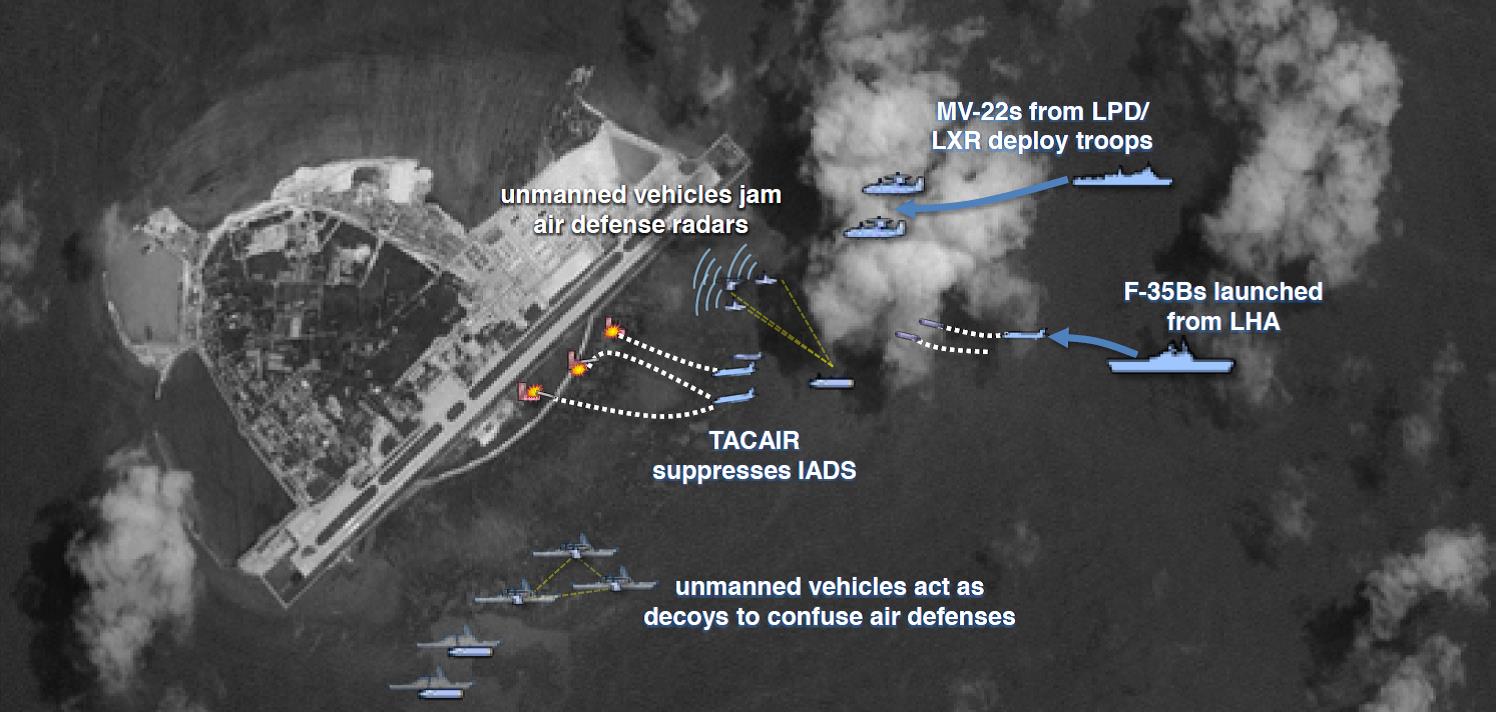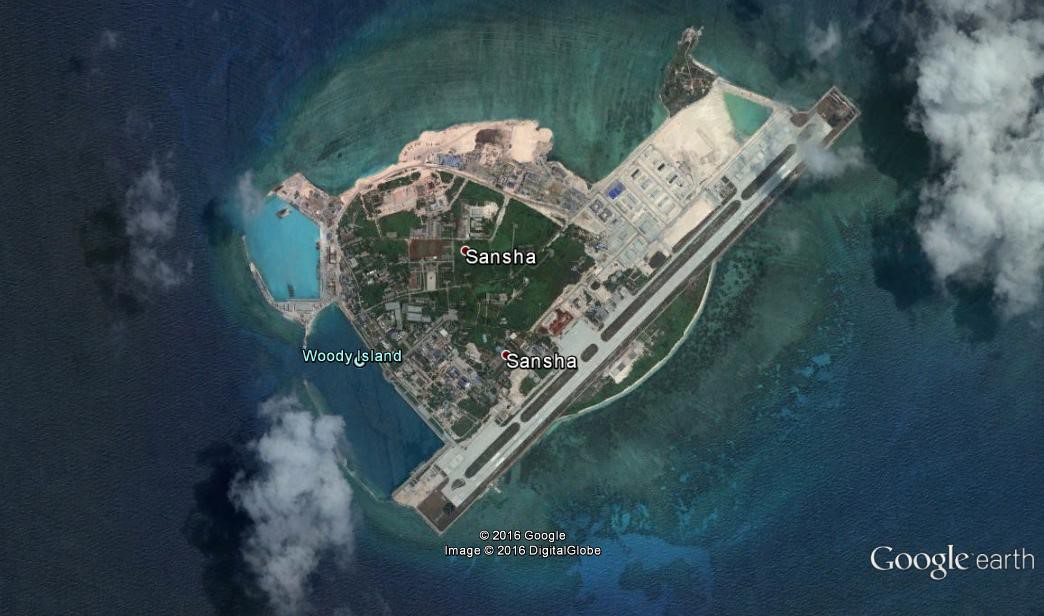An influential Washington think tank, the Center for Strategic and Budgetary Assessments (CSBA), released a new report, Restoring American Seapower – A New Fleet Architecture for the United States Navy, outlining what it thinks the U.S. Navy’s future fleet should look like to defeat Great Powers – China and Russia – in a potential war.
In the past, U.S. analysts and Defense officials often referred to China as a “pacing threat,” and towards the end of the Obama Administration even more diplomatically as a “pacing competitor.” This phrasing allowed the United States to talk abstractly about planning and procuring new weapons systems to defeat Chinese strategies and weapons systems without having to say whether it was planning how to actually fight a war with China—or even thought one would be likely. CSBA’s report dispenses with that diplomatic pretense and designed a recommended future fleet for the United States explicitly to deter China, and failing that, to be able to defeat it decisively.
CSBA’s track record and long associations with the Pentagon suggests many of the study’s recommendations are likely to be adopted or adapted by the U.S. Navy. Some of their earlier work largely shaped the public discussion around the Anti-Access/Area Denial (A2/AD) threat and the Pentagon’s AirSea Battle concept. Deputy Secretary of Defense Robert Work, a rare senior holdover from the Obama Administration, and architect of the Pentagon’s Third Offset strategy to deter peer threats like China and Russia, was CSBA’s Vice President for Strategic Studies before re-entering government service.
The U.S. Navy is already experimenting with many concepts proposed by a 2014 CSBA study to improve the combat effectiveness of its surface fleet. The current report was one of a series of studies ordered by the U.S. Senate in 2015 to inform future shipbuilding decisions, fleet organization, and operational concepts and is receiving high-level political attention.
Gearing up for Great Power War and the China Threat
The study’s premise is that since the end of the Cold War the U.S. military has organized itself principally to face regional threats like Iraq or North Korea, but that its strategic imperatives are changing. Instead, it contends that the United States needs to focus on Great Power threats: China and Russia. It asserts that advances in long range sensors and precision weapons like China’s DF-21 and DF-26 anti-ship ballistic missiles mean it will not be able to count on massing forces to punish aggression after the fact, but must have credible forces present to deter it in the first place.
The report’s planning assumptions are explicit:
Great power competitors such as China and Russia increased their military capabilities over the last two decades and now appear willing to challenge the international order. They are likely, over the next 15 years, to replace transnational terrorism as the primary concern of U.S. military planners.
CSBA believes in both “the growing possibility of great power confrontation” and China’s “capability and willingness…to challenge the status quo,” necessitating that the United States be postured to respond to potential aggression. Specifically, the study says the future U.S. fleet must be able to deter China against using military force against Taiwan, and a conflict related to Chinese-claimed “maritime territory exceeding that allowed by the United Nations Convention on the Law of the Sea (UNCLOS)” in the East and South China Seas.
The strategy CSBA proposes this future fleet employ against China is called “deny-and-punish.” The theory is to maintain sufficient conventional naval forces in the Western Pacific to be able to respond to a crisis quickly and impose unacceptable costs on China’s military efforts, hopefully deterring any attempt to use force in the first place. But if a clash does ensue, not only should the U.S. Navy be able to deny China its military objectives, but also punish that aggression with proportional conventional force.
Showing how New Concepts would work against Chinese Targets
To support its “deny-and-punish” strategy CSBA proposes a variety of innovative warfighting concepts, new ship classes, changes to the fleet’s organization and training, and the integration of a suite of unmanned surface and underwater vehicles to increase the combat effectiveness of manned vessels. Many of these concepts are optimized for the geography of the Western Pacific or against particular Chinese strategic strengths.
CSBA’s future amphibious concepts for how the U.S. Navy and Marine Corps will work together specifically address threats like “China’s missile batteries on islands in the South China Sea.” (While China has deployed Surface-to-Air and anti-ship cruise missiles periodically to Woody Island in the Paracel chain, CSBA does not specify what Chinese missiles this refers to.) Executing their denial and punishment strategy will require U.S. forces to be postured “inside contested areas to interdict aggression.”
The study uses Japan’s Ryukyu islands to illustrate how this concept would deploy Marine units with overlapping anti-air and anti-ship systems on archipelagos “to contain adversary power projection capabilities.” In the case of the Ryukyus, this would serve to keep China’s North and East Sea Fleets bottled up within the first island chain.
Later in a discussion of how CSBA proposes the fleet to be geographically distributed, it makes clear that the Navy’s forces in the East and South China Seas would be set up to be able “to make the first island chain a barrier to Chinese power projection rather than a potential jumping off point for it.”
Though unlabeled in the study, a graphic showing the execution of a notional amphibious raid uses Woody Island in the Paracels as illustration of the concept. China has occupied the island, which is also claimed by Vietnam, since 1974 and calls it Yongxing Dao. Woody Island is also the seat of Sansha city, which China established in 2012 to administer the South China Sea islands it claims sovereignty over.

CSBA’s graphic illustrating Amphibious Raids in Contested Areas

An overhead pictures of Woody Island in the Paracels.
The Future U.S. Fleet in the Pacific
One of the principal changes that CSBA proposes is reorganizing the U.S. Navy into Deterrence Forces and Maneuver Forces. The Deterrence forces would be regionally organized and either forward or rotationally deployed to ensure a consistent presence of credible U.S. power projection, rather than relying on periodic or ad hoc patrols by more generalized forces. Units assigned to Deterrence Forces would be provided training and capabilities specifically tailored to the potential adversaries in their region. The Maneuver Forces would be larger strike groups of multiple aircraft carriers to deliver substantial, sustained power projection in support of a regional Deterrence Force that becomes engaged in a clash.
For the Pacific, CSBA envisions three focused Deterrence Forces based in the East China Sea, South China Sea, and Western Pacific. Again, the study is explicit that its Pacific Deterrence Forces are organized against China as an adversary:
The Deterrence Forces arrayed in the South and East China Seas would be designed to deny or delay Chinese aggression against likely objectives such as Taiwan, the Senkaku Islands, or the Spratly Islands by eliminating Chinese naval forces and advanced bases in the region. They would also be capable of punishing aggression by attacking Chinese targets from inside the first island chain.
and
The Deterrence Force outside the first island chain in the Western Pacific would be closely tied to those in the South and East China Seas, but its role would be focused on attacking Chinese naval forces in the open ocean and conducting long-range strikes against Chinese forces and other targets in the South and East China Seas.
The study does recognize other non-Chinese potential threats in the Pacific, and in addition to its primary role deterring action in Taiwan or the Senkakus, the East China Sea force would be secondarily tasked with responding to any North Korean aggression.
In addition to submarines, amphibious ships, and a variety of support vessels and aviation assets, the regional Deterrence Forces would maintain a substantial and persistent presence of power-projecting warships in the seas surrounding China (note these numbers are what would be operational in the region at any given time and do not include additional forces engaged in training or maintenance):
- In the South China Sea, the Deterrence Force would comprise five destroyers and frigates, five patrol vessels, and two submarine-tracking ocean surveillance ships.
- In the East China Sea, the Deterrence Force would have five destroyers (including at least one Zumwalt-class) and three-to-four frigates, joined by at least three allied warships.
- The Western Pacific Deterrence would include one light aircraft carrier (CVL), three destroyers, three attack submarines, and another two ocean surveillance vessels.
The CVL in the Western Pacific force would be one of a new, smaller carrier type of 40,000-60,000 tons. CSBA proposes these smaller carriers to provide additional and more distributed airborne strike and sea control capabilities to the Deterrence Forces. This flexibility then frees the 100,000 ton Nimitz and Ford-class aircraft carriers currently in the fleet to respond to crisis as required as part of the proposed Maneuver Force.
A New Direction for Sino-U.S. Strategy?
CSBA’s vision for the U.S. Navy’s future fleet is not one that can be executed immediately, but the Trump Administration appears simpatico with the study’s strategic outlook on China and the bigger fleet it recommends. Many of its concepts and idea can be implemented piecemeal, but building the fleet it recommends would likely take more than a decade, and possibly several. Rhetorically, the Trump Administration has signaled a much tougher stance against China, but its execution is uneven.
The U.S. Navy is now on track to reaching 308 ships by 2021. CSBA’s fleet, not including over 40 fast missile craft and 80 large unmanned vehicles, would number 340 ships. The Navy has already said that it needs a fleet of at least 355 ships, and President Trump has promised that the U.S. Navy will “soon be the largest it’s been” and his first budget submission touts to be “a down payment on the President’s commitment to expanding the fleet.”
After making headlines for testimony calling for blocking China’s access to the islands it occupies in the South China Sea, Secretary of State Tillerson clarified his comment, saying that the United States just needed this capability in the event of a “contingency” – a capability CSBA’s plan outlines. Meanwhile Secretary of Defense James Mattis echoed many of the strategic assumptions CSBA’s study makes about China in press appearances and recent testimony to the U.S. Senate. The Secretary said China was “shredding trust” and “increasingly confrontational” in the South China Sea, and “seeking veto power” over the domestic decisions of its neighbors, a reference to coercion of South Korea over the recent deployment of U.S. THAAD missile batteries there.
But if the Trump Administration rhetoric and strategic studies like CSBA’s point to a tenser strategic competition with China, the execution remains uncertain. There are myriad practical, political, and budgetary hurdles to building the bigger fleet that President Trump, the Navy, and CSBA want. And while Administration talk on China has often been tough, little policy has materialized so far. For example, Secretary Mattis supposedly promised to increase freedom of navigation patrols in the South China Sea on an official trip to Japan, but the Trump Administration has reportedly yet to grant the Navy’s requests to actually conduct any.


